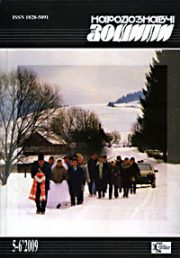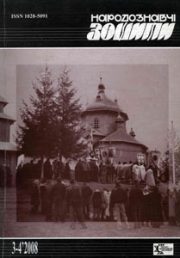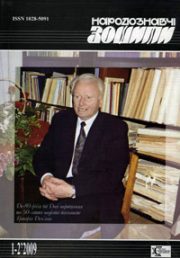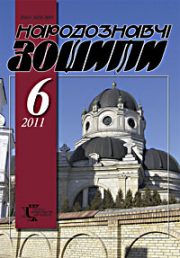The Ethnology Notebooks. 2023. № 2 (170), 343—352
UDK [39(=512.145):314.724(477.75:477.44)]:303
DOI https://doi.org/10.15407/nz2023.02.343
KURIACHA Mariia
- Ph.D student, The Ethnology Institute
- National Academy of Sciences of Ukraine,
- Department of Social Anthropology,
- 15, Svobody Avenue, 79000, Lviv, Ukraine,
- Contacts: е-mail: maria.kuriacha@gmail.com
Abstract. This article is based on the results of the interviews of the project «Crimean Tatars: when we return», which took place among Crimean Tatars displaced to the village of Nova Hreblya, Vinnytsia region. The object of the study is the socio-cultural integration of internally displaced persons as a result of the Russian-Ukrainian war in Vinnytsia. The relevance of the study is determined by the need to study the indigenous people of Crimea in the conditions of the ongoing Russian-Ukrainian war. The Crimean Tatar community, which was interviewed, are active participants in the war and organizers and leaders of the volunteer battalion «Crimea», which has now become part of the Main Directorate of Intelligence of the Ministry of Defense of Ukraine.
The community is also an active participant and organizer of the social and cultural life of Vinnytsia and the region. Using examples and quotes from internally displaced persons, the determinants of the construction and transformation of IDP identities of residents of the East and the South and their integration into a common socio-cultural discourse with the host communities are considered. The research methodology is based on sociocultural approach, which make it possible to study the processes of identification of IDPs in their close relationship with the specific historical conditions of the emergence of a social group, its formation and transformations.
Keywords: Crimean Tatars, internally displaced person, integration, religion, Vinnytsia region.
Received 17.03.2023
REFERENCES
- Belitser, N. (2017). Crimean Tatars as an indigenous people History of the issue and modern realities. Kyiv: Pylyp Orlyk Institute of Democracy [in Ukrainian].
- Gazizova, O. (2022). «The Crimean Tatars in the conditions of integration into the Ukrainian space. The scientific notes Kuras Institute of Political and Ethnonational Studies of the National Academy of Sciences of Ukraine», 4, 437—446 [in Ukrainian].
- Markov, I. (2015). «Migration and ethnicity: some aspects of constructing the horizontal space of coexistence». The Ethnology Notebooks, 6 (126), 1339—1345. Retrieved from: http://nz.ethnology.lviv.ua/archiv/2015-6/10.pdf [in Ukrainian].
- Waldenfels, B. (2002). Introduction to phenomenology. Kyiv: Modern Humanities Library [in Ukrainian].
- Kabuladze, V. (2011). Phenomenology of experience. Kyiv: Spirit and Letter [in Ukrainian].
- Smoliy, V. (Ed.). (2014). Crimea: a path through the ages: history in questions and answers. Kyiv: Institute of History of Ukraine of NASU [in Ukrainian].
- Aydynkaya, І. (2000). Turkish-Ukrainian partnership in economic integration associations. Kyiv: Kyiv National University Institute of International Relations [in Ukrainian].
- «Crimean Tatars. Friends or enemies». Named after T.G.Shev chenko. Retrieved from: https://www.youtube.com/watch? v=_wyYYVREWRY (Last accessed: 26.02.2023) [in Ukrainian].
- «Crimean Tatars. When we return». Memory.org.ua. Retrieved from: https://www.youtube.com/watch?feature=youtu.be&v=1lQzNBYye0E&fbclid=IwAR3-0pi3tJAVnRJorPyGffdlGiRV9CydtTax0Z8zis2tj6-5P4780Wv9CTc&app=desktop (Last accessed: 26.02.2023) [in Ukrainian].
- «How a Crimean Tatar woman created heroes of Ukrainian fairy tales for a school in Vinnytsia». Depo. Retrieved from: https://vn.depo.ua/ukr/vn/krimska-tatarka-ozhivi la-u-shkoli-na-vinnichchini-geroyiv-ukrayinskih-kazok-20180524779531 (Last accessed: 14.02.2023) [in Ukrainian].
- Ukrainer. «Akhtem Seitablaev and his Crimea». Retrieved from: https://ukrainer.net/akhtem-crimea/ (Last acces sed: 09.02.2023) [in Ukrainian].
- «In the village, relations between the local residents and the settlers are getting worse». Vlasno. Retrieved from: http://vlasno.info/suspilstvo/dopomoga/sotszakhist/item/2379-meshkantsi-novoi-hrebli-khochut-vyselyty-krymskykh-tatar (Last accessed: 18.01.2023) [in Ukrainian].
- Zhmud, N. (2020). «Crimean Tatar studies in Vinnytsia region: on the way to understanding (from work experience)». Bulletin of the Faculty of History, Law and Public Administration, 34, 50—52 [in Ukrainian].
- Uretiy, O. (2020). «Crimea» welfare commander Isa Aka yev: «We will definitely return Crimea». Retrieved from: https://armyinform.com.ua/2020/03/komandyr-dobrobatu-krym-isa-akayev-my-povernemo-krym-odnoznachno/ (Last accessed: 09.02.2023) [in Ukrainian].
- Dendyuk, I. (2019). Discussion with the Amet Akimov (audiorecording). Nova Hreblia [in Ukrainian].
- Zhigola, Y. (2019). Discussion with the Hulnara (audiorecording). Nova Hreblia [in Ukrainian].
- Kuriacha, M. (2018). Discussion with the Yulia Piskunova (audiorecording). Vinnytsia [in Ukrainian].
- «The problems of the Crimean Tatars are underestimated in European political debates». Radio Svoboda. Retrieved from: https://www.radiosvoboda.org/a/27745291.html (Last accessed: 16.02.2023) [in Ukrainian].
- Zhigola, Y. (2019). Discussion with the Mukader and Women (a Ukrainian woman who converted to Islam) (audiorecording). Nova Hreblia [in Ukrainian].
- Zhigola, Y., Kokosha, A. (2019). Discussion with the Osmanova Fotinia Nurivna, Osmanova Muniver and the youn gest daughter (audiorecording). Nova Hreblia [in Ukrainian].
- Kokosha, A. (2019). Discussion with the Muniver (audiorecording). Nova Hreblia [in Ukrainian].







